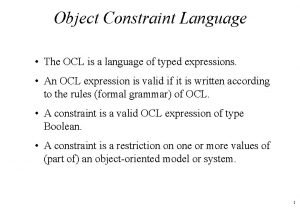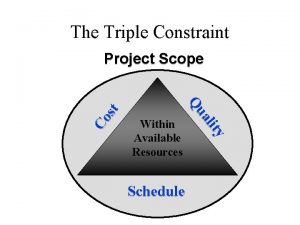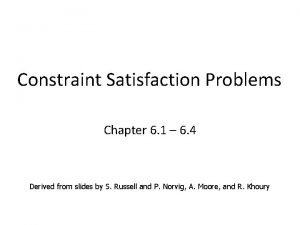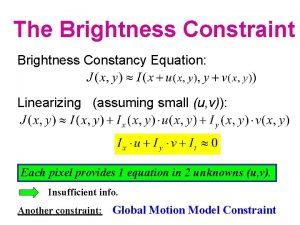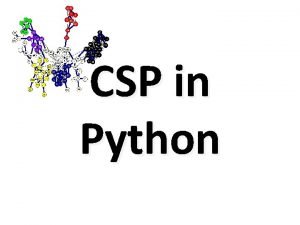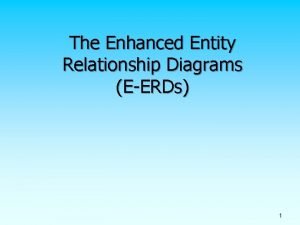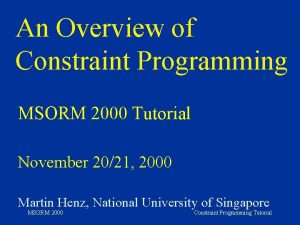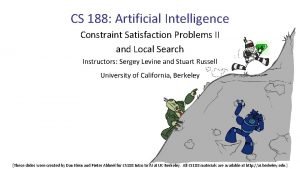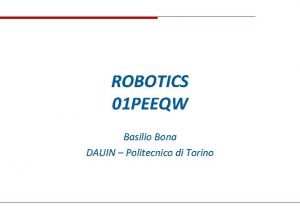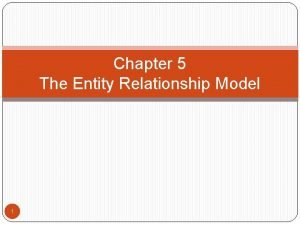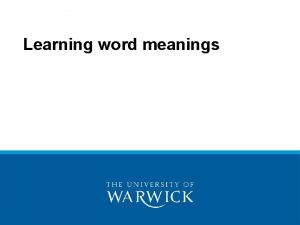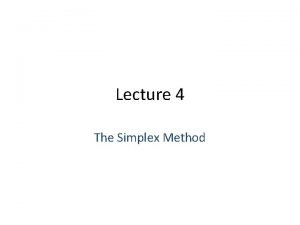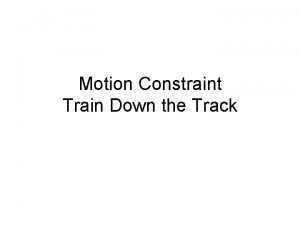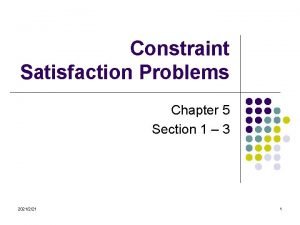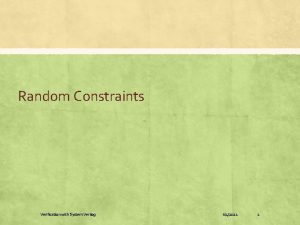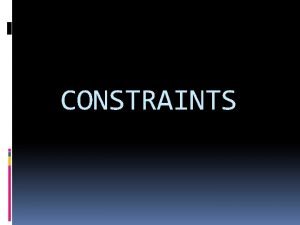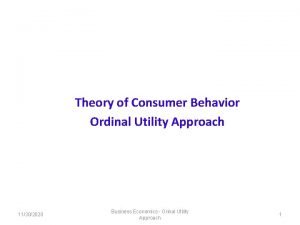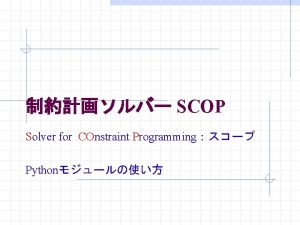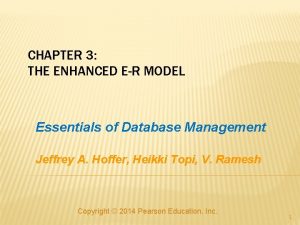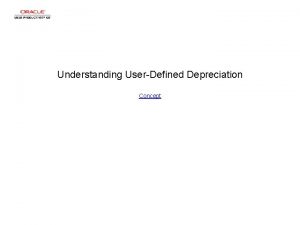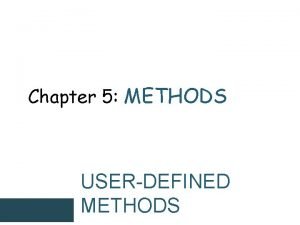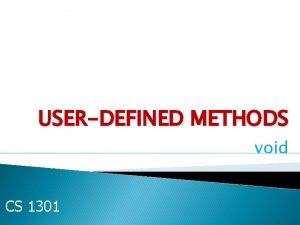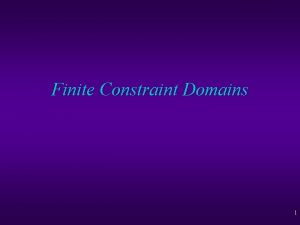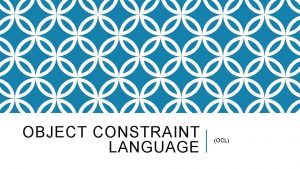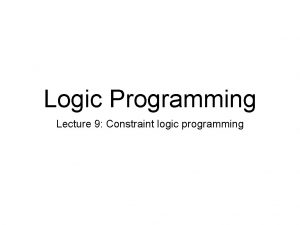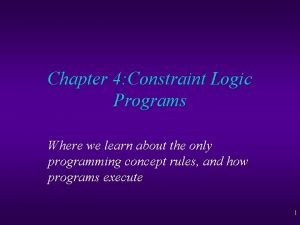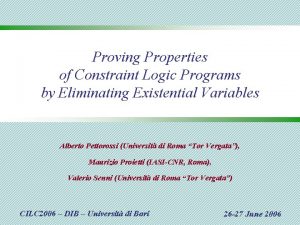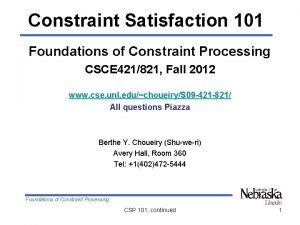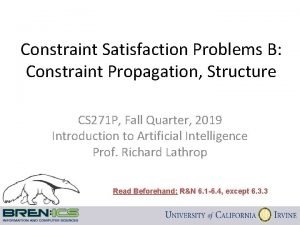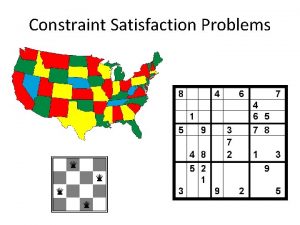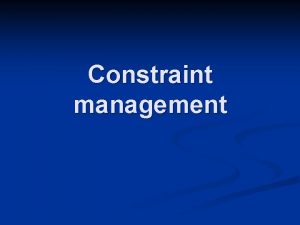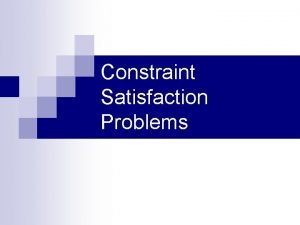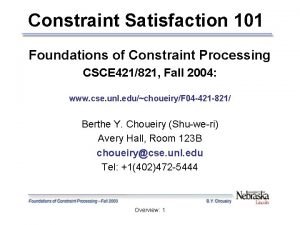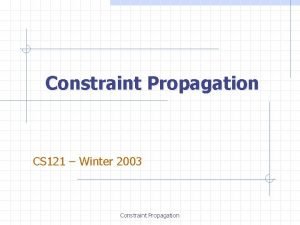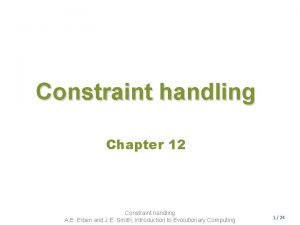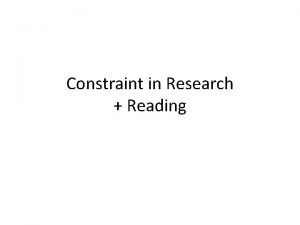Constraint Logic Programs 1 Constraint Logic Programs UserDefined













![Rewriting User-Defined Cons. u goal G of the form (or empty m=0 []) u Rewriting User-Defined Cons. u goal G of the form (or empty m=0 []) u](https://slidetodoc.com/presentation_image/21ea1e5e605ce62858cc77639e8ef8b7/image-14.jpg)





![Derivations For derivation beginning at <G 0 | C 0> u success state: <[] Derivations For derivation beginning at <G 0 | C 0> u success state: <[]](https://slidetodoc.com/presentation_image/21ea1e5e605ce62858cc77639e8ef8b7/image-20.jpg)











![Example Simplified Tree Note: fail states are <[] | false> and success states contain Example Simplified Tree Note: fail states are <[] | false> and success states contain](https://slidetodoc.com/presentation_image/21ea1e5e605ce62858cc77639e8ef8b7/image-32.jpg)



- Slides: 35

Constraint Logic Programs 1

Constraint Logic Programs User-Defined Constraints u Programming with Rules u Evaluation u Derivation Trees and Finite Failure u Goal Evaluation u Simplified Derivation Trees u The CLP Scheme u 2

User-Defined Constraints u Many examples of modelling can be partitioned into two parts ua general description of the object or process u and specific information about the situation at hand The programmer should be able to define their own problem specific constraints u Rules enable this u 3

Rules A user defined constraint to define the model of the simple circuit: parallel_resistors(V, I, R 1, R 2) And the rule defining it parallel_resistors(V, I, R 1, R 2) : V = I 1 * R 1, V = I 2 * R 2, I 1 + I 2 = I. 4

Using Rules parallel_resistors(V, I, R 1, R 2) : V = I 1 * R 1, V = I 2 * R 2, I 1 + I 2 = I. Behaviour with resistors of 10 and 5 Ohms Behaviour with 10 V battery where resistors are the same It represents the constraint (macro replacement) 5

Its not macro replacement! Imagine two uses of parallel resistors parallel_resistors(VA, IA, 10, 5), parallel_resistors(VB, IB, 8, 3), VA + VB = V, I = IB, I = IA After macro replacement (converting comma to conj) Confused the two sets of local variables I 1, I 2 6

Rewriting Example parallel_resistors(VA, IA, 10, 5), VA=V’, IA=I’, 10=R 1’, 5=R 2’, V’ V’ ==parallel_resistors(VB, IB, 8, 3), I 1’*R 1’, V’ V’ == I 2’*R 2’, I 1’+I 2’ == I’, VA + VB IB=I’’, = V, I =8=R 1’’, IB, I =3=R 2’’, IA parallel_resistors(VB, IB, 8, 3), VB=V’’, V’’=I 1’’*R 1’’, VA + VB V’’=I 2’’*R 2’’, = V, rule I = IB, I I 1’’+I 2’’=I’’ = IA Rewrite the first literal with VA + VB = V, I = IB, I = IA parallel_resistors(V, I, R 1, R 2) : - Rewrite the. I 1 8 th*literal V = = I 2 *of. R 2, I 1 + I 2 = Simplifying onto. R 1, the Vvariables interest V and I I. Renaming: parallel_resistors(V’’, I’’, R 1’’, R 2’’) : parallel_resistors(V’, I’, R 1’, R 2’) : - 7 V’’=I 1’’*R 1’’, V’’=I 2’’*R 2’’, I 1’’+I 2’’=I’’. V’ = I 1’*R 1’, V’ = I 2’*R 2’, I 1’+I 2’ = I’.

Programming with Rules A voltage divider circuit, where cell must be 9 or 12 V resistors 5, 9 or 14 voltage_divider(V, I, R 1, R 2, VD, ID) : V 1 = I*R 1, VD= I 2*R 2, V = V 1+VD, I = I 2+ID. cell(9). (shorthand for cell(9) : - []. ) cell(12). resistor(5). resistor(9). resistor(14). 8

Programming with Rules Aim: find component values such that the divider voltage VD is between 5. 4 and 5. 5 V when the divider current ID is 0. 1 A voltage_divider(V, I, R 1, R 2, VD, ID), 5. 4 <= VD, VD <= 5. 5, ID = 0. 1, cell(V), resistor(R 1), resistor(R 2). Note: when rewriting cell and resistor literals there is a choice of which rule to use (V=9, R 1=5, R 2=5) unsatisfiable constraint (V=9, R 1=5, R 2=9) satisfiable constraint 9

Programming with Rules Consider the factorial function, how do we write rules for a predicate fac(N, F) where F = N! (R 1) fac(0, 1). (R 2) fac(N, N*F) : - N >= 1, fac(N-1, F). Note how the definition is recursive (in terms of itself) and mimics the mathematical definition 10

Programming with Rules (R 1) fac(0, 1). (R 2) fac(N, N*F) : - N >= 1, fac(N-1, F). Rewriting the goal fac(2, X) (i. e. what is 2!) Simplified onto variable X, then answer X=2 Different rewriting: the constraints are unsatisfiable 11

User-Defined Constraints user-defined constraint: p(t 1, . . . , tn) where p is an n-ary predicate and t 1, . . . , tn are expressions u literal: a prim. or user-defined constraint u goal: a sequence of literals L 1, . . . , Lm u rule: A : - B where A is a user-defined constraint and B a goal u program: a sequence of rules u 12

Renamings A renaming r is a bijective (invertable) mapping of variables to variables u A syntactic object is a constraint, userdefined constraint, goal or rule u Applying a renaming to a syntactic object gives the object with each variable x replaced by r(x) u variant o’ of object o has renaming r(o’)=o u 13
![Rewriting UserDefined Cons u goal G of the form or empty m0 u Rewriting User-Defined Cons. u goal G of the form (or empty m=0 []) u](https://slidetodoc.com/presentation_image/21ea1e5e605ce62858cc77639e8ef8b7/image-14.jpg)
Rewriting User-Defined Cons. u goal G of the form (or empty m=0 []) u L 1, . . . , Li-1, Li+1, . . . , Lm Li is of the form p(t 1, . . . , tn) u R is of the form p(s 1, . . . , sn) : - B u r is a renaming s. t. vars in r(R) not in G u The rewriting of G at Li by R using renaming r is u u L 1, . . . , Li-1, t 1=r(s 1), . . . , tn=r(sn), r(B), Li+1, . . . , Lm 14

Evaluation In each rewriting step we should check that the conjunction of primitive constraints is satisfiable u derivation does this u in each step a literal is handled u u primitive constraints: added to constraint store u user-defined constraints: rewritten 15

Evaluation state: <G 1| C 1> where G 1 is a goal and C 1 is a constraint u derivation step: G 1 is L 1, L 2, . . . , Lm u u L 1 is a primitive constraint, C 2 is C 1 / L 1 u if solv(C / L 1) = false then G 2 = [] u else G 2 = L 2, . . . , Lm u L 1 is a user-defined constraint, C 2 is C 1 and G 2 is the rewriting of G 1 at L 1 using some rule and renaming 16

Evaluation u derivation for <G 0 | C 0>: u where each <Gi | Ci> to <Gi+1 | Ci+1> is a derivation step u derivation for G is a derivation for the state <G | true> 17

Derivation of fac(1, Y) Corresponding answer simplified to Y is Y = 1 18

Derivation for fac(1, Y) A failed derivation for fac(1, Y) 19
![Derivations For derivation beginning at G 0 C 0 u success state Derivations For derivation beginning at <G 0 | C 0> u success state: <[]](https://slidetodoc.com/presentation_image/21ea1e5e605ce62858cc77639e8ef8b7/image-20.jpg)
Derivations For derivation beginning at <G 0 | C 0> u success state: <[] | C> where solv(C) != false u successful derivation: last state is success u answer: simpl(C, vars(<G 0 | C 0>)) u fail state: <[] | C> where solv(C) = false u failed derivation: last state is fail state u 20

Derivation Trees u derivation tree for goal G u root is < G | true > u the children of each state are the states reachable in one derivation step Encodes all possible derivations u when leftmost literal is prim. constraint only one child u otherwise children ordered like rule order u 21

Derivation Tree Example failed derivation answer: Y = 1 failed derivation 22

Derivation Trees The previous example shows three derivations, 2 failed and one successful u finitely failed: if a derivation tree is finite and all derivations are failed u next slide a finitely failed derivation tree u infinite derivation tree: some derivations are infinite u 23

Finitely Failed Example 24

Infinite Derivation Tree (S 1) stupid(X) : - stupid(X). (S 2) stupid(1). Answer: X=1 Infinite derivation 25

Goal Evaluation of a goal performs an in-order depth-first search of the derivation tree u when a success state in encountered the system returns an answer u the user can ask for more answers in which case the search continues u execution halts when the users requests no more answers or the entire tree is explored u 26

Goal Evaluation Example Return answer: Y = 1 more? Return no 27 more

Goal Evaluation Example 2 The evaluation never finds an answer, even though infinitely many exist 28

Simplified Derivation Trees Derivation trees are very large u A simplified form which has the most useful information u u constraints in simplified form (variables in the initial goal and goal part of state) u uninteresting states removed 29

Simplified State u simplified state: <G 0 | C 0> in derivation for G u replace C 0 with C 1=simpl(C 0, vars(G, G 0)) u if x=t in C 1 replace x by t in G 0 giving G 1 u replace C 1 with C 2=simpl(C 1, vars(G, G 1)) u Example 30

Simplified Derivation A state is critical if it is the first or last state of a derivation or the first literal is a userdefined constraint u A simplified derivation for goal G contains all the critical states in simplified form u similarly for a simplified derivation tree u 31
![Example Simplified Tree Note fail states are false and success states contain Example Simplified Tree Note: fail states are <[] | false> and success states contain](https://slidetodoc.com/presentation_image/21ea1e5e605ce62858cc77639e8ef8b7/image-32.jpg)
Example Simplified Tree Note: fail states are <[] | false> and success states contain answers 32

The CLP Scheme The scheme defines a family of programming languages u A language CLP(X) is defined by u u constraint domain X u solver for the constraint domain X u simplifier for the constraint domain X Example we have used CLP(Real) u Another example CLP(Tree) u 33

CLP(R) Example domain for chapters 5, 6, 7 u Elements are trees containing real constants u Constraints are for trees u and for arithmetic u 34

Constraint Logic Programs Summary u rules: for user-defined constraints u multiple rules for one predicate u can be recursive u derivation: evaluates a goal u successful: gives an answer (constraint) u failed: can go no further u infinite u scheme: defines a CLP language 35
 Cpmcd full form
Cpmcd full form Combinational vs sequential logic
Combinational vs sequential logic Combinational logic sequential logic 차이
Combinational logic sequential logic 차이 First order logic vs propositional logic
First order logic vs propositional logic Cryptarithmetic problem logic+logic=prolog
Cryptarithmetic problem logic+logic=prolog Combinational logic sequential logic
Combinational logic sequential logic First order logic vs propositional logic
First order logic vs propositional logic Software project wbs example
Software project wbs example First order logic vs propositional logic
First order logic vs propositional logic Majority circuit
Majority circuit Intertemporal budget constraint
Intertemporal budget constraint Ocl language
Ocl language Quadruple constraints in project management
Quadruple constraints in project management Summing point constraint
Summing point constraint Triple constraint diagram
Triple constraint diagram Backtracking search algorithm for csp
Backtracking search algorithm for csp Jelaskan animasi dengan object constraint
Jelaskan animasi dengan object constraint Brightness constancy constraint
Brightness constancy constraint Python csp
Python csp Erd supertype subtype
Erd supertype subtype Constrained crossword
Constrained crossword Constraint programming tutorial
Constraint programming tutorial Csp problem in ai
Csp problem in ai De luca
De luca Existence dependent entity
Existence dependent entity Mutual exclusivity constraint
Mutual exclusivity constraint Simplex method problem
Simplex method problem Flush constraint
Flush constraint Constraint graph
Constraint graph Constraint accounting
Constraint accounting Verilog urandom
Verilog urandom Rheonomic constraints
Rheonomic constraints Inventor constraint symbols
Inventor constraint symbols Ordinal utility
Ordinal utility Constraint programming python
Constraint programming python Partial specialization rule
Partial specialization rule











